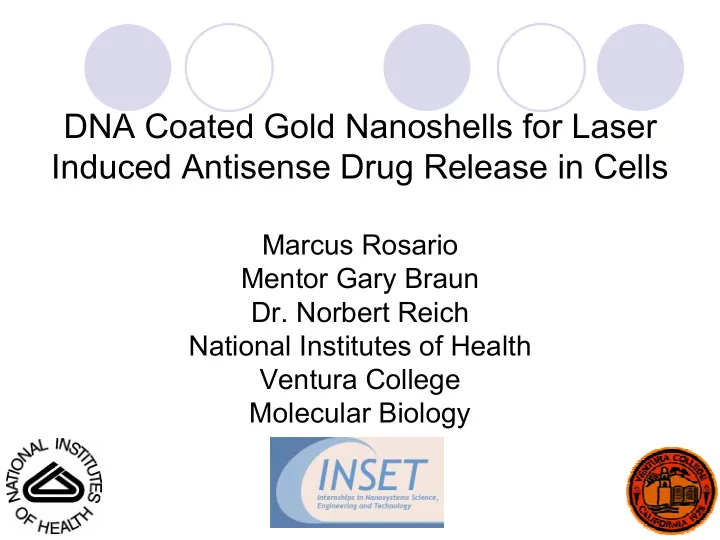

DNA Coated Gold Nanoshells for Laser Induced Antisense Drug Release in Cells Marcus Rosario Mentor Gary Braun Dr. Norbert Reich National Institutes of Health Ventura College Molecular Biology
The Big Picture Research Goals � Attach antisense DNA to gold nanoshells � Introduce nanoshells to cells for intracellular delivery � Activation via pulsed laser to release DNA in a time and position-specific manner Real World � Would enable time-resolved and spatial gene function studies (antisense, silencing RNA, and micro RNA)
Overview F Research Objectives F � Coat nanoshells with thiol-DNA-dye S � Demonstrate delivery into cells S F S � Release DNA-dye via pulsed laser 45nm without killing the cells F S m n 7 Approach � Characterization of DNA-nanoshells thiol-Au � Cell viability on nanoshell films bond � Effect of variable conditions on pulsed laser release Water-filled � laser power, laser exposure time cavity � Initial studies using a chemical release (excess thiol)
Nanoshell Structure and Surface Chemistry F F S F DNA: HSC 6 H 12 -5’-CGC ATT CAG GAT(F)- 3’ S F S F λ = 800nm S O S F H S Femtosec pulses S F Hot F S S electrons S or 10-100 mM BME OH 10x to 20x increase in ~95% quenched fluorescence fluorescence (near the NS surface) (diffusion away from NS)
Pulsed Laser Releasing DNA Laser Target
Verifying DNA Release using Fluorescence � Gold nanoshells quench Pulsed Laser release (10x increase) DNA-dye fluorescence � Laser causes DNA separation from NS and increases the fluorescence of the solution � Quantitated using a fluorimeter and through fluorescence imaging with a microscope
Microscope Imaging Release from NS- Films Power Dependence of DNA Release after 3 min exposure 160 Film Fluorescence (40x, arb. 140 120 100 units) 80 60 40 20 0 0 50 100 150 200 250 300 Power (mW) Note: No immediate cell death at these powers!
DNA Transfection Strategies � Simple Incubation � Cationic Polymers � Electrostatically-induced endocytosis � Targeting using Peptides or Antibodies � Receptor-Mediated Endocytosis � Transferrin � Viral Capsids � Adenovirus � Our approach: Cationic Polymer-Nanoshell Composites in solution and films (“Surfection”) � Branched-Polyethylenimine (PEI) � HeLa (cervical cancer cells, cultured on plates) Fu-Hsiung Chang et al. Surfection: a new platform for transfected cell arrays. Nucleic Acids Research , 2004, Vol. 32, No. 3
Chemical BME-Release: Nanoshell-PEI Solution-based Transfection with HeLa Before BME After ~15 min BME Fluorescein channel + + PEI-nanoshell Fluorescence increases after BME clusters on cells release of DNA-dye + + + + + Fl +
Surfection with HeLa Cells HeLa Cell (-) - - - - - - DNA-dye NS (-) - - - - + + - - PEI (+) + + + + + - - - - + + + Gelatin (+/-) + + + + - + + + + + + + + + + + Poly-L-Lysine (+) Glass slide
Cell Viability on Surfection Films Optimal Surfection composition: White light 0.01% PLL (100kD) F l for 15 min 1% branched-PEI / 40x 1% Gelatin mixture for 15 min Trypan Blue 30 min Nanoshell fluorescence Dead cell Filter deposition in PBS 50% coverage with HeLa, 10% FBS 40x Cy3 High P, Low G, CRF, HeLa,10x
BME Release of DNA-Dye inside HeLa Cells BME Quenched DNA-dye-NS Increased fluorescence BME BME
BME Release of DNA-Dye inside HeLa Cells Top: A wide field view of the BME-released DNA-dye observed in ~ 40% of cells. Bottom: A control experiment shows no increase in fluorescence when nanoshells are absent Without Nanoshells BME
Analysis Summary � DNA release from NS was observed at moderately low laser powers after 3 min exposure, or by addition of BME � Cell death was not observed at powers much higher than needed for DNA release (~50 uJ/pulse per cm 2 ) � Verified that PEI-Gelatin films allow for good cell viability � Uptake of DNA-nanoshells was demonstrated using chemical release with fluorescence increase
Future Plans � Show laser release of DNA inside cells � Improve surfection technique � Use more stable fluorescent dyes � Deliver known, chemically-resistant, antisense DNA sequences � Verify gene knockdown � Use other cell lines to test generality
Acknowledgements � Mentor Gary Braun � Dr. Norbert Reich & His Lab � Nick Fera for the HeLa cells � Alexander Mikhailovsky for use of the pulsed laser � INSET Facilitators & Fellow Interns
References � Boussif, Lezouhal’c et al. “A versatile vector for gene and oligonucleotide transfer into cells in culture and in vivo: Polyethylenimine”. PNAS 1995. Vol. 92, 7297-7301. � Fu-Hsiung Chang et al. “Surfection: a new platform for transfected cell arrays”. Nucleic Acids Research , 2004, Vol. 32, No. 3. � Huang, El-Sayed. “Cancer Cell Imaging and Photothermal Therapy in the Near-Infrared Region by Using Gold Nanorods”. JACS 2006, 128, 2115-2120. � Mikhailovsky, Zasadzinski. “Inside-Out Disruption of Silica/Gold Core- Shell Nanoparticles by Pulsed Laser Irradiation”. Langmuir 2005, 21, 7528-7532.
Thank You
Recommend
More recommend